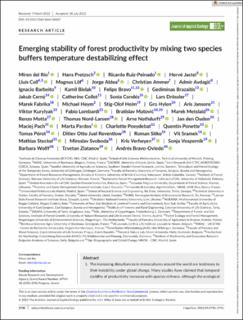| dc.contributor.author | del Río, Miren | |
| dc.contributor.author | Pretzsch, Hans | |
| dc.contributor.author | Ruiz-Peinado, Ricardo | |
| dc.contributor.author | Jactel, Hervé | |
| dc.contributor.author | Coll, Lluis | |
| dc.contributor.author | Löf, Magnus | |
| dc.contributor.author | Aldea, Jorge | |
| dc.contributor.author | Ammer, Christian | |
| dc.contributor.author | Avdagić, Admir | |
| dc.contributor.author | Barbeito, Ignacio | |
| dc.contributor.author | Bielak, Kamil | |
| dc.contributor.author | Bravo, Felipe | |
| dc.contributor.author | Brazaitis, Gediminas | |
| dc.contributor.author | Cerny, Jakub | |
| dc.contributor.author | Collet, Catherine | |
| dc.contributor.author | Condés, Sonia | |
| dc.contributor.author | Drössler, Lars | |
| dc.contributor.author | Fabrika, Marek | |
| dc.contributor.author | Heym, Michael | |
| dc.contributor.author | Holm, Stig-Olof | |
| dc.contributor.author | Hylen, Gro | |
| dc.contributor.author | Jansons, Aris | |
| dc.contributor.author | Kurylyak, Viktor | |
| dc.contributor.author | Lombardi, Fabio | |
| dc.contributor.author | Matović, Bratislav | |
| dc.contributor.author | Metslaid, Marek | |
| dc.contributor.author | Motta, Renzo | |
| dc.contributor.author | Nord-Larsen, Thomas | |
| dc.contributor.author | Nothdurft, Arne | |
| dc.contributor.author | den Ouden, Jan | |
| dc.contributor.author | Pach, Maciej | |
| dc.contributor.author | Pardos, Marta | |
| dc.contributor.author | Poeydebat, Charlotte | |
| dc.contributor.author | Ponette, Quentin | |
| dc.contributor.author | Perot, Thomas | |
| dc.contributor.author | Reventlow, Ditlev Otto Juel | |
| dc.contributor.author | Sitko, Roman | |
| dc.contributor.author | Sramek, Vit | |
| dc.contributor.author | Steckel, Mathias | |
| dc.contributor.author | Svoboda, Miroslav | |
| dc.contributor.author | Verheyen, Kris | |
| dc.contributor.author | Vospernik, Sonja | |
| dc.contributor.author | Wolff, Barbara | |
| dc.contributor.author | Zlatanov, Tzvetan | |
| dc.contributor.author | Bravo-Oviedo, Andrés | |
| dc.date.accessioned | 2023-02-23T18:54:36Z | |
| dc.date.available | 2023-02-23T18:54:36Z | |
| dc.date.created | 2022-08-29T17:54:08Z | |
| dc.date.issued | 2022-08-06 | |
| dc.identifier.citation | Journal of Applied Ecology. 2022, 59 (11), 2730-2741. | en_US |
| dc.identifier.issn | 0021-8901 | |
| dc.identifier.uri | https://hdl.handle.net/11250/3053695 | |
| dc.description.abstract | The increasing disturbances in monocultures around the world are testimony to their instability under global change. Many studies have claimed that temporal stability of productivity increases with species richness, although the ecological fundamentals have mainly been investigated through diversity experiments. To adequately manage forest ecosystems, it is necessary to have a comprehensive understanding of the effect of mixing species on the temporal stability of productivity and the way in which it is influenced by climate conditions across large geographical areas. Here, we used a unique dataset of 261 stands combining pure and two-species mixtures of four relevant tree species over a wide range of climate conditions in Europe to examine the effect of species mixing on the level and temporal stability of productivity. Structural equation modelling was employed to further explore the direct and indirect influence of climate, overyielding, species asynchrony and additive effect (i.e. temporal stability expected from the species growth in monospecific stands) on temporal stability in mixed forests. We showed that by adding only one tree species to monocultures, the level (overyielding: +6%) and stability (temporal stability: +12%) of stand growth increased significantly. We identified the key effect of temperature on destabilizing stand growth, which may be mitigated by mixing species. We further confirmed asynchrony as the main driver of temporal stability in mixed stands, through both the additive effect and species interactions, which modify between-species asynchrony in mixtures in comparison to monocultures. Synthesis and applications. This study highlights the emergent properties associated with mixing two species, which result in resource efficient and temporally stable production systems. We reveal the negative impact of mean temperature on temporal stability of forest productivity and how the stabilizing effect of mixing two species can counterbalance this impact. The overyielding and temporal stability of growth addressed in this paper are essential for ecosystem services closely linked with the level and rhythm of forest growth. Our results underline that mixing two species can be a realistic and effective nature-based climate solution, which could contribute towards meeting EU climate target policies. | en_US |
| dc.description.abstract | Emerging stability of forest productivity by mixing two species buffers temperature destabilizing effect | en_US |
| dc.language.iso | eng | en_US |
| dc.publisher | John Wiley & Sons Ltd on behalf of British Ecological Society | en_US |
| dc.rights | Navngivelse-Ikkekommersiell 4.0 Internasjonal | * |
| dc.rights.uri | http://creativecommons.org/licenses/by-nc/4.0/deed.no | * |
| dc.title | Emerging stability of forest productivity by mixing two species buffers temperature destabilizing effect | en_US |
| dc.title.alternative | Emerging stability of forest productivity by mixing two species buffers temperature destabilizing effect | en_US |
| dc.type | Peer reviewed | en_US |
| dc.type | Journal article | en_US |
| dc.description.version | publishedVersion | en_US |
| dc.rights.holder | © 2022 The Authors | en_US |
| dc.source.pagenumber | 2730-2741 | en_US |
| dc.source.volume | 59 | en_US |
| dc.source.journal | Journal of Applied Ecology | en_US |
| dc.source.issue | 11 | en_US |
| dc.identifier.doi | 10.1111/1365-2664.14267 | |
| dc.identifier.cristin | 2046907 | |
| dc.relation.project | EC/H2020/778322 | en_US |
| dc.relation.project | EC/FP7/606803 | en_US |
| cristin.ispublished | true | |
| cristin.fulltext | original | |
| cristin.qualitycode | 2 | |

